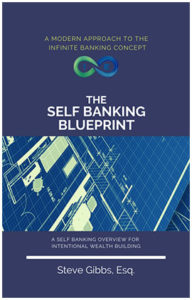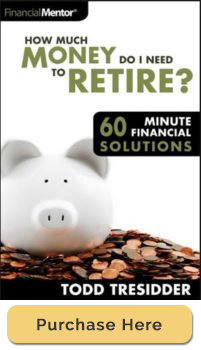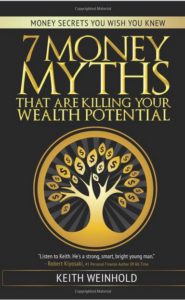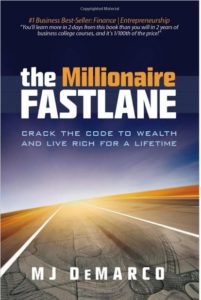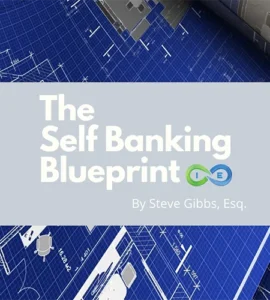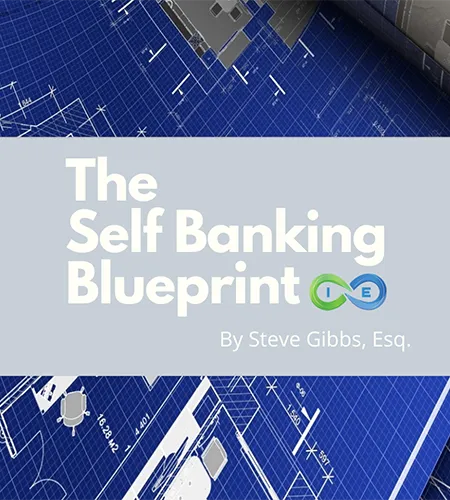Review of How Much Money do I Need to Retire?
Anyone that has questions about their retirement, or even just their future for that matter, should read this book by Todd R. Tresidder. Todd does an excellent job of explaining the most popular methods for calculating the amount of money that an individual (or couple) will need to retire and live financially secure. But that’s not really what this book brings to the table.
Todd explains the popular methods, but then he also showcases, with intimate detail, the massive risks and flaws that exist with those methods. By the time you finish the first major section of this book, you will hopefully have a good deal of concern and worry for those that use the most common methods of retirement planning, such as using 401k Plans. Fortunately the book doesn’t end there.
In How Much Money do I Need to Retire, Todd outlines the risks and flaws of the most popular methods and then in the last two major sections of the book, he describes alternative methods of retirement planning that mitigate those risks and eliminate the flaws. In fact, the final section of the book is a quick and easy to understand retirement planning method that is as certain and secure as any I’ve seen.
Having said that, it’s important to add that the final method presented is not necessarily easy to accomplish. Just like it’s not easy to save millions of dollars in an investment account prior to retirement. But the method Todd suggests doesn’t have the same risks and flaws of the other methods.
Okay, let’s jump into it…
Todd opens the book with a quick introduction that presents the problem that many of us know is pervasive, namely, that only 14% of Americans are confident they will be able to retire and be financially secure. Two facts stood out to me from the New York Times. First, that 75% of Americans have less than $30,000 in their retirement accounts. Second, that 49% of middle-class workers will be classified as poor or near poor upon retirement. Many may be aware of these dire statistics, but knowing about them doesn’t solve the problem. We need to know how to push those figures in the right direction, so more and more Americans can afford to retire with a lifestyle they choose.
Model One: Conventional Retirement Planning Method
How Much… presents the problem all Americans face in the Introduction, and then in the first section of the book the reader is given the first model for retirement planning; also known as the Conventional Retirement Planning Method. What is presented, is basically what a typical client would experience upon sitting down with a financial advisor and discussing their retirement.
Todd provides the most common seven questions that are asked of any client that wants to know how much money they need to retire. The answer to these seven questions will provide you with the “retirement number” – also known as the amount you need to have saved on the day of your retirement.
- How much income do I need for retirement?
- How does inflation impact the amount of money I need for retirement?
- How does life expectancy impact the amount of money I need to retire?
- How much will my company pension and Social Security pay during retirement?
- How much investment income can I expect during retirement?
- How does the order of returns and market valuation affect your investment return assumption?
- What age will you and your spouse retire?
Now it might seem daunting to see these questions in written form and to think about answering them accurately. Good. That’s exactly how you should feel when you’re presented with questions that ask you to predict the future with some sort of accuracy. If you go online and look at just about any retirement calculator, you’ll see these questions. The calculator will want to know when you plan to retire, how long you expect to live, the rate of return you expect, etc.. And when you sit down with a financial planner, they will likely pull up a calculator of their own choosing and ask you these very same questions. They may guide you here and there, but ultimately the calculator will spit out a number and you’ll have to live with it.
The problem with all this supposed science and sophistication, according to Todd, is that these financial plans that are produced by conventional advisors are “precise but not accurate.” They have a lot of pages of data that look very complicated and technical, but in the end, it isn’t accurate because it’s trying to predict the future with too many uncertain variables.
Todd offers this advice:
The key is not which calculator you choose, but which assumptions you choose for the calculator.
If you assume 8% annual returns, your outlook may look pretty good, but is that assumption really accurate? Todd also points out that we’ve had entire decades where the stock market lost money, and decades when it did much better than the average. So your assumptions really do make or break your retirement number.
Let’s take a look at the questions listed above individually. Todd addresses the first 6 in his book, but leaves question 7 to the reader to determine.
Question 1: How Much Income Do I Need For Retirement?
Todd points out that the traditional financial planning model estimates that you will need 75%-85% of your working income to support your lifestyle in retirement. But the statistics don’t support this assumption, and they don’t take into consideration the healthcare costs of those that might need long-term care. So what do you do? Todd advises that you “make your best guestimate.” And he doesn’t leave us hanging, he provides a five step process to complete the “guesstimate.”
- Start calculating your retirement spending estimate by using one full year of your current spending as the benchmark. Include all items paid annually… Make sure you get as complete a picture as possible.
- Adjust those spending expectations for any unique plans you have for retirement.
- As you get older, you can expect to spend less in nominal dollars so go ahead and build that into your retirement plan in nominal dollars.
- Next, adjust your expected spending for inflation.
- Finally, add an assumption for long-term care costs depending on whether or not you are purchasing insurance.
Question 2: How Does Inflation Impact The Amount Of Money I Need For Retirement?
Do you think inflation is an important factor to consider? Consider this fact from How Much…
From the 1960s to the early 1980s, the unweighted stock market adjusted for inflation lost roughly 80% of its value.
You read that correctly, “LOST roughly 80% of it’s value.” So, yes, inflation is important.
Todd states his opinion that inflation is the “single biggest threat to your retirement because it can’t be accurately estimated, you have no control over its occurrence, and the effect is compounded over time, thus magnifying small errors into big problems.”
The recommendation is to try a variety of expected inflation rates and see how your retirement plan holds up to each.
Question 3: How Does Life Expectancy Impact The Amount Of Money I Need To Retire?
We do not know for certain how long we will live. We can look to the insurance companies and their actuarial data to determine the probabilities, but individuals are always possible outliers. Any of us could be the oldest living person on the planet at the end of our life. Odds are against it, but it’s possible. So how do we account for this?
My personal opinion happens to be in line with the book on this one, but I don’t want to give it away just yet, because the book provides the solution much later. I will say that a good life insurance policy would be considered an asset for just about anyone that was looking for retirement. This asset, if structured properly, such as with paid up additions, would allow for interest income that doesn’t eat into principle and thus fits nicely with the strategies that don’t need to figure Life Expectancy into the equation.
Question 4: How Much Will My Company Pension and Social Security Pay During Retirement?
How Much… states clearly that Social Security is not a program we should be relying upon. There is no line item in the government budget for Social Security, it’s just a transfer of wealth from those that are currently earning, to those that are not currently earning. In the future, the earners will decrease and the non-earners will increase. Does that sound sustainable to you?
Todd mentions, and I agree, that politically it’s unlikely that Social Security will disappear. But it is likely that the benefits will diminish over time.
For those that think their pension is rock solid, do yourself a favor and google “pension default.” Too many people have put all their eggs in one pension basket only to have the bottom of the basket fall apart.
Question 5: How Much Investment Income Can I Expect During Retirement?
The averages do not work, so if you’re going to use a number, you best make it a conservative one. According to How Much… the investment advisors like historical averages and returns because they are easy to explain and show to clients. Unfortunately, these numbers have little impact on the future.
Todd is quick to deliver a scathing reproach to the investment community when he says they want “…you to believe a government-sponsored retirement plan (401(k), IRA, Roth IRA, etc.) stuffed with the stocks, bonds, and mutual funds…” is the only option. When in reality there are many alternatives that are often even more secure and certain, especially when considering the 401k withdrawal penalties.
Todd offers the following options as non-traditional options that can fund a retirement:
- Rental Real Estate
- Active (Skill-Based) Investors
- Dividend Paying Stocks
- Business Income or Sale
Question 6: How Does the Order of Returns and Market Valuation Affect Your Investment Return Assumption
Let me throw another quote at you from Todd:
The amount of return you can expect from a diversified equity portfolio is inversely correlated to the market valuation at the start of the holding period.
What is Todd saying here? To be clear, he isn’t just giving his opinion here, he provided the research to back it. In layman’s terms, if you look at the market valuation on the day you retire, you can determine (with a good degree of certainty) how well your portfolio will do against the average in the coming decade. If you retire when the market valuation is high, it is highly likely your average return over the next decade will be below average. The opposite is also true. If you retire when the market valuation is low, it is likely your average return over the next decade will be above average.
As mentioned earlier, the book doesn’t address question 7, What age will you and your spouse retire? But he does give us a rather technical section on calculators and confidence intervals. I’m going to leave that section for you to read if you so choose.
I will stress that the book makes it clear that the calculators and technical details don’t really amount to much if your assumptions are incorrect. Todd states that two numbers are hyper-critical to the success of your conventional retirement plan.
Critical Numbers
1. Percentage of income saved versus income spent.
Todd mentions that he retired at the age of 35 by saving approximately 70% of his relatively high income as a hedge fund manager for a period of 10 years. He lived like a meager college student for those years and now he can live a much better life because he saved like crazy. This method is true for anyone that chooses to save a massive portion of their income. The greater the percentage of your income is saved each year, the shorter the time frame to retirement.
2. Return on investment minus inflation.
Inflation is a killer, as mentioned earlier in the review. This number can make or break your retirement. So what do you do? Choose retirement income that grows with inflation, like rental real estate, or dividend paying stocks.
Moving forward Todd suggests that retirement planning should more correctly be viewed as “life planning.” People get caught up in trying to acquire more and more assets, to chase the “magic number.” But they would be better served by doing some solid “life planning” instead.
To be honest, at this point in the book, I think most people (if they made it through the technical details in this section) will feel a little disheartened, if not downright depressed. And I think this might be a bit intentional on the part of the author. Because if you’re frustrated and despondent over your retirement outlook, you’re likely in a good place to receive the message that is forthcoming in the last two sections.
Todd has presented the problem (most Americans are not prepared for retirement), and he’s provided the current accepted solution (which we can clearly see is full of many flaws and risks). In the coming sections he presents an alternative solution (model) that eliminates many of the risks, and all of the flaws.
Model Two: Creative Lifestyle Planning>
This second model for retirement planning involves adjusting your lifestyle to fit your budget, instead of growing your savings to meet your budget. Remember what was said earlier in the book, that the conventional model for retirement essentially says that we should plan on spending about 75%-85% of our annual working income during retirement. This second model of retirement planning turns that assumption on it’s head.
For example, let’s say you work in San Francisco and make $200,000 per year as a couple. Conventional retirement planning would suggest that you will need at least $150,000 per year in retirement. While that may be very true if you stay in the same location, it’s not so true if you move to Phoenix, Arizona? Or what if you bought an RV and traveled the country for 4 years? Your annual costs would be reduced significantly.
Todd suggests that you tackle the biggest expenses first, such as Housing, Taxes, and Healthcare. And he points out that for every $1000 reduction in your monthly retirement expenses you reduce your savings need by approximately $300,000. That is a big deal! The conventional model stresses the need to earn an additional $300,000 in savings to make up $1000 a month in retirement spending. But if you can reduce your spending, you can retire earlier, or with less money. That is the key to this model.
Think of retirement like supply and demand. You can work your entire life trying to increase your supply to meet the demand you have created during your working years. Or you can reduce your demand and therefore reduce you required supply.
How Much… also looks at passive income with this model of retirement. Passive income is that income that is generated without active effort by the owner. In other words, you don’t have to spend eight hours a day actively earning your paycheck. Instead, your asset creates the income for you while you passively sit on the sideline. Rental income is a good example of passive income.
For every $1000 earned in passive income, you reduce your needed savings by $300,000. Todd correctly states that just a couple of rental properties acquired in your 40’s or 50’s will generate significant passive income throughout your retirement. And the property is a hedge against inflation – in other words the value of the property (rents) typically increase along with inflation.
Finally, Todd suggests that individuals may be able to earn much more than a traditional investment portfolio, via active investment trading, business and hobby business profits, or pretty much whatever your creative self may be able to produce during retirement. His point is just that you don’t have to settle for a 5% adjusted annual return on your savings, you may be able to use your creativity and your expertise in ways that generate a return well in excess of the traditional averages.
Helpful tips for retirement planning
There are a lot of helpful tips and suggestions throughout the book that I wanted to share before moving onto Model 3.
Buckets of Risk: Break up your retirement into two buckets; Needs, and Wants. Consider using inflation adjusting annuities to supplement your savings and Social Security income to account for your Needs. This is a way to eliminate the risk of outliving your money.
Extreme Frugality: This is a suggestion that is fairly common among the alternative retirement book authors. You can read all about it in books like Early Retirement Extreme, or How to Retire Happy, Wild, and Free. Both books will showcase the benefits of living a frugal life in retirement. Todd shares his own early retirement success story by stating that he was able to retire at age 35, after working for 10 years as a hedge fund manager and saving 70% of his income each year. Living frugal has its benefits, if you can do it.
Time: This should be easy for everyone to understand.
When time is short, focus on saving and spending, and when time is long, focus on investment return net of inflation. This is a key principle.
Convert Hobbies Into Income: I don’t know if I agree with the author on this note. Everyone wants to be able to make money on their hobbies. It’s something you read about in all sorts of business books like The 4-Hour Workweek. I know that some people are able to do just that, and especially when your hobby is in the financial industry. But if your hobby is popular, the market for goods and services in that market is probably over-saturated. It’s not impossible, but it’s probably not as easy as many people make it out to be. But by all means make money on your hobby if you can. Just be careful, joyful endeavors lose their flavor when you need them to produce income. As a former video game developer I speak from experience.
Phased Work: The idea of phased work is that you don’t quit all at once. Consider working only a few months a year. Certain occupations lend themselves to this sort of work better than others. I know a couple that travel the globe working in restaurants as servers. Every country they visit typically has some openings and they only need to work a few months a year to fund their travels. Did I mention they live in a van? Their expenses are low, but they consider their quality of life to be off the charts.
Alternative Sources of Income: We have a studio apartment over our garage that we rent to a newlywed couple. This sort of arrangement works well for us. I know many cities that are opening up the regulations to permit tiny houses on the lots of existing home owners as a means of addressing the affordable housing issue. These tiny houses can cost as little at $30,000 for a complete home on wheels. Plug it into your power, connect the water, and you may be able to charge $1000 or more in rent (much more in San Francisco).
Longevity Risk Management Strategies: A few considerations for those worried about living too long. We mentioned earlier that you can purchase annuities to complement your other retirement income and meet your needs. Another strategy would be to purchase longevity insurance annuities that only start paying at age 85. These are relative inexpensive, and will help offset the risk of living too long. Finally, you can budget to live until age 85 while living in a paid off house. If you live longer you can use the equity in your house as income beyond that threshold.
Change Your Spending Pattern: The final tip in the book that I will pass along is that you can change your spending pattern according to portfolio returns. If your portfolio increases in value, you can increase your spending. And likewise, when your portfolio decreases in value, you tighten your belt and decrease spending. You can fix your spending to a percentage of your portfolio, or give yourself inflation increases only when your portfolio increases in value. You get the picture, pay attention to your return and act accordingly.
Model 3 – Cash Flow Planning
This is the model that Todd used to retire at age 35. This model is extremely simple and easy to understand. I LOVE this model! And personally I can’t see spending much time worrying about the models above when you can just jump to this model and be done with it. Okay, enough of the commentary, here it is.
Model 3 is a 3 rule system. Follow each rule and you achieve success. No calculator needed.
Rule 1: Build a portfolio of residual income that exceeds expenses
This is probably self explanatory, but you can only spend the income generated by the assets. You need to leave the assets alone. In other words, you can’t refinance your home and spend the money. You can spend the rent from the home, but the equity remains untouched, even as it appreciates. If you choose to pull some money out and re-invest in another rental property, that’s fine. But the money you pull out should be re-invested as opposed to spending the money on that binge party in Vegas you’ve always dreamed of throwing.
Rule 2: Manage your portfolio so that the assets outpace inflation
This rule allows you to ignore the risk of inflation by maintaining a pace that exceeds it. For those looking for securities that account for inflation, you can choose TIPS (Treasury Inflation-Protected Securities) which take inflation into account. Or you could own real estate and know that the value is likely to reflect inflation. I’m sure you get the point, your asset needs to appreciate with inflation in some way. If your assets do this automatically, you’ll rest easy knowing that the number one killer of retirement accounts has been eliminated.
Rule 3: Income must come from multiple, non-correlated sources
The future is uncertain, so having all your eggs in one basket is unwise. I love rental income, but what if the real estate laws change and make it much more difficult on property owners. Cash Value Life Insurance is a tremendous asset and a great way to remove the tax burden that eats into so many retirement accounts, but what if the government changes the laws regarding life insurance policy loans. Dividend paying stocks have a good track record of returning value, but what if the unforeseen happens, like some jumbo jet crashing into a building. All this to say that the future is uncertain, and even the assets with the best track record have some risk. Diversifying your portfolio is just one more hedge against the uncertain future. If your income is being produced from a variety of assets that are not correlated, you can have confidence that you’ll weather the storms that may come.
Not to mention the fact that a diverse portfolio is a tremendous education. You will be much more knowledgeable about the variety of investments if you succeed in following this rule. Your pet favorite investment may prove to be inferior to something else you research down the road. Do your due diligence and you’ll be rewarded.
So there you have it, what Todd considers to be the most simple and effective model for retirement planning. And I think you’ll agree after reading his book – I know I do.
I do my best to do a thorough review of the books I read (even if I don’t post them online), because it helps me remember the material and act upon it. But I must stress that I believe the book is far superior to my little online review.
Todd R. Tressider does a tremendous job of outlining the three models for retirement planning without leaving stones unturned. For those that want the technical details and the challenging analytics, they are included. For those that prefer to hear the model in relatively simple terms, you can skip the tech section and just grab the meat that suits your taste. If you’re looking for retirement solutions, do yourself a favor and read this book.
In addition, I would add that if you’re looking for help with your infinite banking or whole life insurance planning, please don’t hesitate to give us a call. We consider cash value life insurance to be a great asset for individuals in all walks of life – it is an asset that increases with inflation, avoids taxation, provides instant financing for any need, while providing protection against the unknown. To find out more, give us a call.
